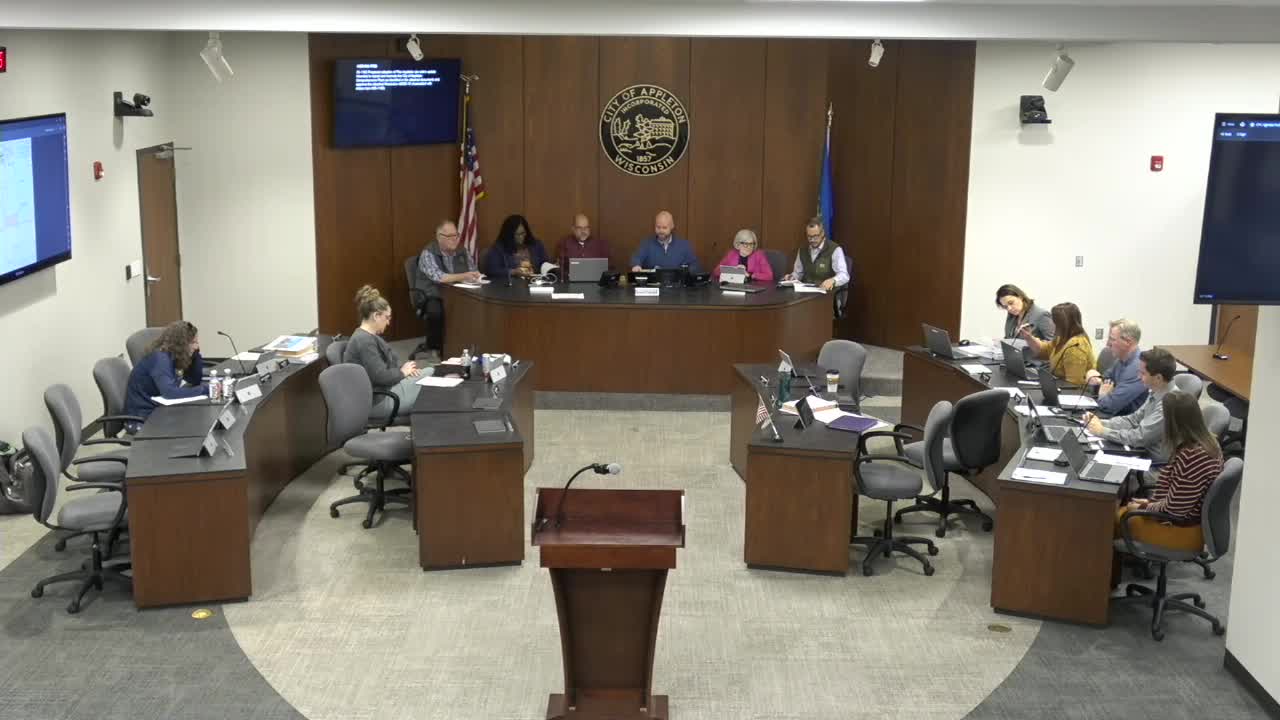Plan Commission forwards updated ‘Plan Appleton’ comprehensive plan to council after unanimous approval
October 08, 2025 | Appleton City, Winnebago County, Wisconsin
This article was created by AI summarizing key points discussed. AI makes mistakes, so for full details and context, please refer to the video of the full meeting. Please report any errors so we can fix them. Report an error »

The Appleton City Plan Commission on Oct. 8 voted to approve and forward to the Common Council a proposed repeal-and-replace update to the city’s comprehensive plan, branded "Plan Appleton." The commission’s recommendation will be transmitted to the Common Council for its November review.
Lindsey (planning staff) presented the draft update and said the plan has been restructured from topic‑based “elements” into an intro (vision and issues), a goals chapter (with metrics and strategies), an implementation chapter, and an appendix containing data and subarea/corridor plans. Lindsey said the vision statement developed through community engagement was left unchanged and that the draft includes seven overarching goals tied to measurable outcomes and implementation actions. She explained that smaller‑scale corridor and subarea plans are included or carried forward (Richmond Street and Northland Street; South Oneida; Wisconsin Avenue; plus Downtown Plan, Fox River Corridor Plan and the College North Neighborhood Plan).
Staff emphasized public engagement and described the feedback summary: Lindsey said a substantial share of respondents offered positive feedback or general comments, and that about 12% of responses prompted clarifications or minor edits to wording and graphics (for example changing the term "nearby" to the clearer legal term "abutting" for neighborhood‑designation adjacency and noting that certain housing data were pulled in 2023). She also said roughly 72% of respondents responded positively that the vision statement captured the community’s aspirations for the next 10–20 years, and about 83% felt the future land use categories were clearly articulated.
Two items that staff initially ranked as high priorities were moved to medium priority after public input: creating a complete set of street amenities for pedestrians (lighting, shading, seating) and conducting a comprehensive traffic study for the subareas. Lindsey said other high priorities identified by the public focus on zoning or code changes to enable redevelopment and mixed‑use development in targeted subareas. The implementation framework assigns timeframes (near, mid, long term), "champions" (typically the Community Development Department with partner departments such as Public Works and Parks & Rec) and performance metrics to actions.
Alder Fenton (alderperson) praised staff and the public engagement process during remarks, and other commissioners echoed gratitude to staff and members of the advisory committee that guided the work. The public hearing produced no commenters at the commission meeting.
Action and next steps: the commission moved and seconded approval; the presiding officer announced the motion carried with no opposition. The commission’s recommendation will be transmitted to the Common Council for its public hearing and vote (Common Council review scheduled for Nov. 19). Staff encouraged commissioners and members of the public to continue to submit questions or comments before the council hearing.
Lindsey (planning staff) presented the draft update and said the plan has been restructured from topic‑based “elements” into an intro (vision and issues), a goals chapter (with metrics and strategies), an implementation chapter, and an appendix containing data and subarea/corridor plans. Lindsey said the vision statement developed through community engagement was left unchanged and that the draft includes seven overarching goals tied to measurable outcomes and implementation actions. She explained that smaller‑scale corridor and subarea plans are included or carried forward (Richmond Street and Northland Street; South Oneida; Wisconsin Avenue; plus Downtown Plan, Fox River Corridor Plan and the College North Neighborhood Plan).
Staff emphasized public engagement and described the feedback summary: Lindsey said a substantial share of respondents offered positive feedback or general comments, and that about 12% of responses prompted clarifications or minor edits to wording and graphics (for example changing the term "nearby" to the clearer legal term "abutting" for neighborhood‑designation adjacency and noting that certain housing data were pulled in 2023). She also said roughly 72% of respondents responded positively that the vision statement captured the community’s aspirations for the next 10–20 years, and about 83% felt the future land use categories were clearly articulated.
Two items that staff initially ranked as high priorities were moved to medium priority after public input: creating a complete set of street amenities for pedestrians (lighting, shading, seating) and conducting a comprehensive traffic study for the subareas. Lindsey said other high priorities identified by the public focus on zoning or code changes to enable redevelopment and mixed‑use development in targeted subareas. The implementation framework assigns timeframes (near, mid, long term), "champions" (typically the Community Development Department with partner departments such as Public Works and Parks & Rec) and performance metrics to actions.
Alder Fenton (alderperson) praised staff and the public engagement process during remarks, and other commissioners echoed gratitude to staff and members of the advisory committee that guided the work. The public hearing produced no commenters at the commission meeting.
Action and next steps: the commission moved and seconded approval; the presiding officer announced the motion carried with no opposition. The commission’s recommendation will be transmitted to the Common Council for its public hearing and vote (Common Council review scheduled for Nov. 19). Staff encouraged commissioners and members of the public to continue to submit questions or comments before the council hearing.
Don't Miss a Word: See the Full Meeting!
Go beyond summaries. Unlock every video, transcript, and key insight with a Founder Membership.
✓
Get instant access to full meeting videos
✓
Search and clip any phrase from complete transcripts
✓
Receive AI-powered summaries & custom alerts
✓
Enjoy lifetime, unrestricted access to government data
30-day money-back guarantee

